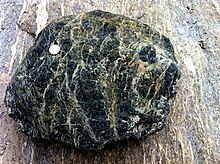



Serpentinite is a metamorphic rock composed predominantly of serpentine group minerals formed by serpentinization of mafic or ultramafic rocks. The ancient origin of the name is uncertain, it may be from the similarity of its texture or color to snake skin.[1] Greek pharmacologist Dioscorides (AD 50) recommended eating this rock to prevent snakebite.[2]
Serpentinite has been called serpentine or serpentine rock, particularly in older geological texts and in wider cultural settings.[3][4][5][6][7]
Most of the chemical reactions necessary to synthesize acetyl-CoA, essential to basic biochemical pathways of life, take place during serpentinization. Serpentinite thermal vents are therefore considered a candidate for the origin of life on Earth.
- ^ Schoenherr, Allan A. (11 July 2017). A Natural History of California: Second Edition. Univ of California Press. pp. 35–. ISBN 9780520295117. Retrieved 6 May 2017.
- ^ Faust, George T.; Fahey, Joseph J. (1962). "The Serpentine-Group Minerals" (PDF). USGS Numbered Series (384-A): 3. doi:10.3133/pp384A. Retrieved 27 September 2024.
The Term Serpentine
- ^ "serpentine". Merriam-Webster.com Dictionary. Merriam-Webster. Retrieved 6 March 2022.
- ^ California Government Code § 425.2; see "CA Codes (Gov:420-429.8)". Archived from the original on 28 June 2009. Retrieved 24 December 2009.
- ^ Oakeshott, G.B. (1968). "Diapiric Structures in Diablo Range, California". AAPG Special Volume M8:Diapirism and Diapirs. 153: 228–243.
- ^ Flett, J.S. (1913). "The geology of the lizard". Proceedings of the Geologists' Association. 24 (3): 118–133. Bibcode:1913PrGA...24..118F. doi:10.1016/S0016-7878(13)80008-9.
- ^ González-Mancera, G.; Ortega-Gutiérrez, F.; Nava, N.E.; Arriola, H.S. (2003). "Mössbauer Study of Serpentine Minerals in the Ultramafic Body of Tehuitzingo, Southern Mexico". Hyperfine Interactions. 148 (1–4): 61–71. Bibcode:2003HyInt.148...61G. doi:10.1023/B:HYPE.0000003765.32151.3b. S2CID 96761317.